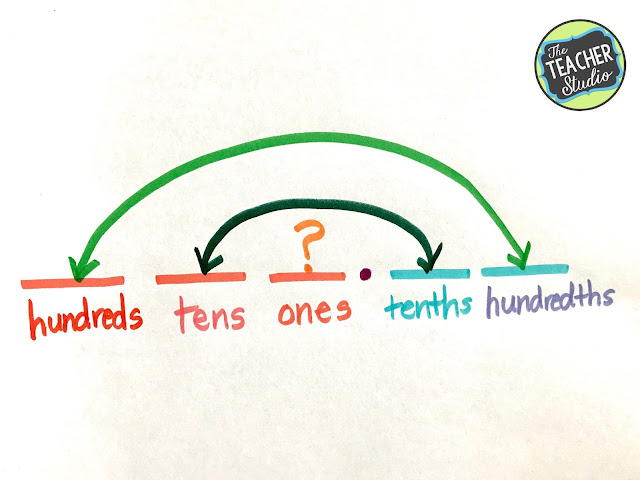In terms of decimal places, the 'columns' are powers of whatever base you are using: in decimal, that is base 10. So the powers of ten, for each 'place' relative to the decimal point, look like so near the decimal point:
104 103 102 101 100 . 10-1 10-2 10-3 10-4 etc
Note that 100 = 1, so the 'oneths' place is before the decimal place. Also note that every other power is paired by its opposite power on the other side of the decimal.
So the reason there isn't a 'oneths' place on the right side of the decimal is because the two sides are symmetrically paired (10-2 and 102, 10-1 and 101, etc) and there is no pair for 100 .
But for the sake of discussion, what would a 'oneths' place to the right of the decimal look like? Powers on the right are negative, so - for example - a 4 in the 'tenths' column really means
4 * 10-1 = 4 / 101 = 4 * 1/10 = 0.4
So postulate that there should be a 'oneths' to the right of the decimal place:
4 * 10-0 = 4 / 100 = 4 / 1 = 4
but this yields exactly the same value as the 'oneths' column to the left of the decimal place:
4 * 100 = 4 * 1 = 4
Since multiplying by one and dividing by one give the exact same answer, it would be redundant to have them both (which would double whatever was in the ones/oneths column) and it would break the symmetry, the logical progression of powers from
4 3 2 1 0 . -1 -2 -3 -4 etc
comments:
A "tenth" is called a "tenth" because you need ten of them to make a one. If you had something that you needed one of to make a one, that would be a one. And there's already a place for that.
If by "behind" you mean "to the right of," then the answer is because that would be redundant. The digit immediately to the left of the decimal point indicates single units. It would be counterproductive to have a second digit also bearing the same value. A HundredsTensOnes.Tenths system prevents confusing redundancy.
If we had a HundredsTensOnes.OnesTenths system then 5.6 and 11 would be the exact same number. Rather than teaching everyone two different ways to write everything, the "after the decimal" part of a number starts with tenths -- the next logical step in a base-10 progression. All the useful information about a number can be expressed without two columns spanning an identical range of values.
|
|
